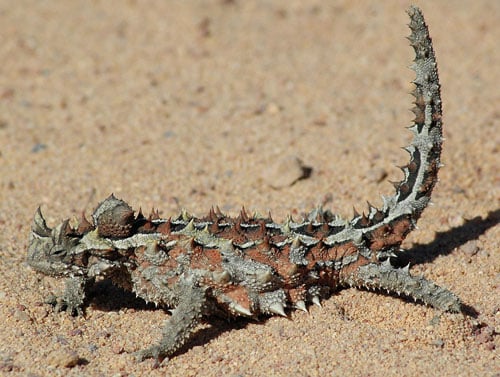Information on Australia's thorny devil lizard.
The world’s oldest, flattest and most geologically worn continent is found south of the equator between the Indian, Southern and Pacific oceans. Because of its ancestral Gondwana connections, Australia is known, to this day, for its unusual flora and fauna.
If you like reptiles, visions of Australia’s lizards may be conjured up, especially desert species, from legless pygopodids (flap-footed lizards) to swift and predatory monitors, locally known as goannas. Mixed among these is one species of a monotypic genus that seems not so much to come from an unusual continent, but more likely to originate from another planet. Scientists have known this lizard since 1841 as Moloch horridus, the Australian thorny devil (also known as the moloch).
This lizard is widely distributed in Australia’s arid regions: Western Australia, South Australia, Northern Territory and western Queensland. Aridity and soil conditions appear to be the major factors in determining where Moloch horridus lives. In the center of Australia’s vast interior thorny devils occur on sandy plains and long sand ridges where spinifex is abundant, while to the southwest they occur in areas of short eucalyptus trees and other shrubs (the Australians call such areas “mallee”).
Enveloped in Spines
Almost every feature of a thorny devil’s appearance says this animal is strange, easily the weirdest lizard anyone is likely to ever see.
They are covered with long spines and elongated scales protrude in every direction. The tips of the spines are narrow, sharp and smooth. Between these widely dispersed and long-pointed scales are areas of small-sized scales, rhombic and varied in shape.
However, it is the many rows of spines extending down the back from the neck to the end of the tail, and on all of the limbs, that seem to truly define the animal. Even on the relatively spineless belly surface, there are short, sharp, conical spines scattered across this otherwise smooth-scaled surface. On the head, each nostril appears to be guarded from above by a small conical spine, and a huge spine, with smaller neighbors, protrudes from above each eye.
The elongated neck has a whorl of spines directly behind the head, and a broad, well-scaled and well-defined structure protrudes directly above the neck, almost as if resting on it. This boss has two very stout conical spines, one projecting to each side of the lizard. The lateral spines on this “pseudo head” seem to repeat the spine architecture of the “horns” above the eyes.
Across the moloch’s sides and back are 10 or more rows of sharp spines that extend down the rest of the body. A smaller number of rows pass back between the upper sides of the hind legs, which are equally as spiny, before extending out to the tip of the tail.
The surface of the thorny devil’s back is visually broken up and thrown into relief by spines and color patterns of varying brightness, giving it the appearance of a mass of dried and shriveled plant material sitting on the desert sand.
Colors and Patterns
Up close, thorny devils can have a bright and colorful appearance, although at a distance the colors mimic those found in nature and enable these lizards to remain difficult to detect.
An active thorny devil has a yellowish background color covered in bold bright blotches of red, yellow or brown and highlighted by narrow black lines. The blotch colors are specific to lizards living on similarly colored substratum. Broken white lines extend down the middle and sides of the back. The effectiveness of this coloration in disguising thorny devils is memorable to anyone tracking one through wind-smoothed sand and finally seeing it at the end of its spoor.
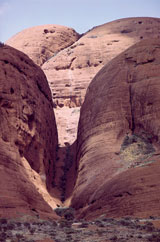
Wade C. Sherbrooke
The rock formations known as the Olgas are thought to be the site of thorny devil origins by central Australian Aborigines.
Thorny devils are capable of rapid color change, an ability that depends on the reaction of pigmented cells in the dermis of the skin. This does not mean that devils can change to any color of their background or that their basic arrangement of patterns changes.
At cooler temperatures and during morning inactivity devils are distinctly dark, with ground colors being greenish and the blotches being olive. There is a clear connection between the brightness of a lizard’s color and its increase in body temperature and activity. Nevertheless, even a fully warmed devil at the peak of the morning’s heat will darken quickly as it passes from sunlight to the shadows of a shrub or small tree.
Molochs on the Move
Thorny devils are more likely to be found active on the surface in spring and fall, rather than midwinter (June and July in the Southern Hemisphere) and midsummer (January and February). During inactive periods their movements are short, or they remain within the protective cover of shrub complexes or burrows. Western Australian devils were more active during early spring (September and early October) than during late spring and early summer (late October and early November).
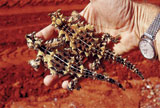
Wade C. Sherbrooke
These two thorny devils were captured in Uluru National Park in Central Australia. Thorny devils will sometimes inflate when they are picked up, thus appearing larger to predators and increasing the effectiveness of their spines.
Male thorny devils are not territorial, but during seasonal activity individuals exhibit sharp differences in movement behavior. In one study some animals moved as little as a few yards a day, whereas others moved 55 to 110 yards a day. Males moved, on average, twice as far as females (35 yards per day compared to 73 yards) during the early spring.
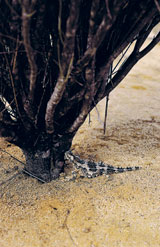
Wade C. Sherbrooke
This thorny devil is picking off ants as they gather nectar from a shrub. Studies indicate that the average adult consumes 750 ants a day.
Presumably, males were searching for mating opportunities. The longest run by a male in a day was 338 yards. Some thorny devils appear to be very sedentary, and they remained within a 100-yard radius of where they were originally found after three years. Others moved as far away as five miles over an 18-month period. The reasons for these movement patterns are little understood.
Ant Eaters
Some biologists refer to thorny devils as “sit-and-wait” predators, I think of them as “search-sit-and-feast” predators. The prey eaten during these feasts are particular species of tiny ants, and the diet is so restricted to these ants, that molochs may have the narrowest menu of any lizard in the world.
It is usually found feeding on the streaming masses of one of several species of tiny ants of the genus Iridomyrmex. A devil may stand above or at the side of an ant column as it picks off passing morsels. Or a thorny devil will sit at the base of a currant bush and eat ants of the genus Crematogaster, as I have observed in Western Australia.
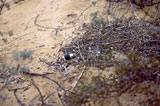
Wade C. Sherbrooke
Thorny devil sleeping site.
.
For more than 100 years, scientists have kept track of thorny devil feeding speeds: ants per minute, number of ants per meal or daily estimates of ants consumed by individuals. One early estimate of the typical moloch meal was that it consisted of 1,000 to 1,500 tiny, “evil-odored,” black ants. Another author, based on a rate of ingestion of 45 ants per minute over a 15-minute meal, and factoring in both morning and afternoon meals, calculated 1,350 ants eaten per day. The contents of two largely filled stomachs were examined and reported to each contain about 2,500 ants. Modern calculations based on water turnover rates in thorny devils suggest that on average adults eat about 750 ants per day.
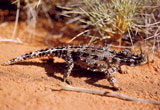
Wade C. Sherbrooke
Thorny devils don’t run from danger – they walk. It is believed that this slow-motion escape may actually confuse predators, so as to not elicit the usual pounce-and-attack approach used with other quick-fleeing prey.
.
Once the molecules of energy and water are extracted from the ants, the chitinous exoskeletons are passed out the vent as large, smooth-surfaced fecal pellets. These are easily recognizable, because of their size, elongated and spheroidal shape, and jumbled contents of ant parts.
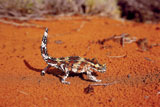
Wade C. Sherbrooke
This thorny devil is walking with its tail aloft. Some think this is for balance, others for defense, but no one is quite sure.
Thorny devil fecal pellets are not randomly scattered across the landscape by the lizards, but are placed over several days in a latrine site, where 20 or more pellets may be found. Still unknown is whether or not the pellets are deposited by one or several lizards (it is probably the former).
A Drink From Its Skin
One of the most fascinating discoveries of drinking behavior in any reptile resulted from the collection of two thorny devils near Mundi-Windi in northwestern Australia on August 26, 1922. The entomologist J. Clark went to the trouble to carry these two lizards 200 miles by camel before continuing south via a motor trip to Perth, arriving on September 6. The devils were then placed into a small, tightly fitted metal box (9 inches by 4 inches by 11/2 inches) that was securely wrapped in brown paper. They were shipped to H.W. Davey all the way across the continent to Melbourne. The nearly suffocated lizards arrived on September 12. Luckily, they recovered the next day.
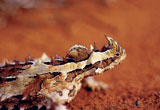
Wade C. Sherbrooke
Thorny devils arethought to have branched away from another lineage of lizardss, about 15 million years ago. As a result, there is nothing quite like it among today’s lizards.
Once Davey determined that they preferred certain ants, they thrived. In 1923 Davey was the first to report his observations on the remarkable hygroscopic nature of thorny devil skin, presumably with the animal drinking through the walls of its body. He reported that its skin “absorbs moisture almost as readily as blotting paper.”
This unlikely scenario for a desert lizard, having skin permeable to water (water is more likely to move out than in), was not formally questioned until 1962.
Two scientists at the University of Western Australia, in Perth, used a colloidal blue dye to show that water actually moves up and across the surfaces of moloch skin very rapidly in all directions, including up and onto the head and back. It did not penetrate the skin surface. The dyed water from the skin’s surface was found in a lizard’s stomach after the animal, standing in dyed water, slowly and slightly opened and closed its jaws.
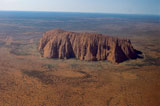
Wade C. Sherbrooke
Ayers Rock is prime thorny devil habitat, but most visitors rarely ever see the thorny devil in the wild.
.
The researchers suggested that movement of water up the thorny devil’s skin was caused by capillary forces generated by the water’s adhesion to tiny grooves in the surface of the scales. They noted that this mechanism might afford the lizard a drink from dew or sporadic showers.
In 1982, the water-transport hypothesis was again revised. Researchers now noted that the water carried over the skin by capillary action actually did not move across the surfaces of scales, where it may be initially captured, but it moved down channels between individual scales, subsequently flowing through this channel network toward the mouth for ingestion.
Because of the lack of rain in Australian deserts, these scientists suggested this mechanism was really used to collect dew as it condensed on the devil’s spines (especially the smooth tips). The dew then ran down onto the scales. Such a system required that cold lizards be exposed to conditions of high humidity in warmer air, perhaps early in the morning, to induce condensation. The dew-capture hypothesis for the devil’s spines remains unproven in nature.
By a Thread
I spent January and February of 1990 in Australia trying to find thorny devils standing in the rain. No one had ever reported seeing Moloch horridus drink in nature, only under captive conditions. I not only found several devils across the continent, but even in the driest areas it rained as well. And I discovered a behavior that expanded our understanding of how well the thorny devil’s water-capture system works in nature.
In the Great Victoria Desert of southwestern Australia, a colleague and I taped spools of thread to the tails of devils. From these, a line of thread unwound as the lizards walked along. Thread trails could then be followed to rapidly relocate the lizards. Thorny devils were relocated right after a light shower fell early one morning and again after a shower the following afternoon. Each time the rain would moisten a thin upper layer of loose sand, about a half-inch deep, as it soaked in. Following the thread trails, next to several lizards I found circular patches of disturbed sand and sand on the lizards’ legs and backs. These lizards had been rubbing their bellies into the moist upper layer of sand, in a rotating fashion, and throwing damp sand onto their own backs.
Subsequent study by my colleague, at the University of Western Australia, demonstrated that when a moloch places its belly on wet sand, the skin’s capillary system of water transport results in drinking and weight gain. So even after a brief shower passes, a devil can continue extracting water molecules from between grains of sand — it just lowers its belly and rubs.
Sexing Molochs
It can be difficult to distinguish the sexes. Adult females tend to be larger, longer and stouter (usually about 80 to 110 millimeters in snout-to-vent length, while males do not exceed 96 mm).
Young adults begin mating at about 3 years of age, but before their full adult size is reached. A full mating-copulatory sequence has never been reported. So we only have a limited understanding of moloch mating behaviors.
At the South Australia Museum, a captive thorny devil responded to an image on a mirror placed in its cage with rapid vibrations of its head, suggesting some form of visual species recognition and social communication. In another setting, this time in an outdoor enclosure, the activities of a female and two devils of unknown sex were observed. The two unknowns nodded their heads in sequence for roughly a minute as they faced each other. After which, they walked side-by-side for a meter before parting company. During the head nodding, the forebody of each was raised and their tails were flat against the ground. But during side-by-side walking the tails of both lizards were arched over their backs.
In another report of an apparently sexually excited pair, the male rapidly bobbed its head, and the female flattened herself on the ground and rapidly tapped the ground with her forefeet. In still another group of captive lizards, one was seen to aggressively rush another and vigorously push and butt its companion with its horns, a behavior that “would do credit to the reputation of a Lilliputian buffalo,” as one researcher put it. These various observations do not provide a complete enough picture to fully answer the old porcupine question: “How do they mate with all those spines?”
Female thorny devils apparently have a very direct way of rejecting the advances of unwelcome males. When a male seeks to straddle up onto the back of a nonreceptive female, she responds by rapidly spinning over 360 degrees and throwing him off.
Maternal Activities
Females dig nests and lay their eggs during October, November and December. Nest digging is laborious for female devils, and it may take three or more days, depending on the weather and soil, to tunnel at an angle below the surface and excavate an egg chamber. A female digs simultaneously with both legs on one side, then she switches to the other two legs, going back and forth.
The length of the tunnel may be 12 to 24 inches. The egg chamber at its end may be 12 inches below ground level and hollowed to the size of an orange. A female will deposit three to 10 eggs in the chamber (usually eight; one report describes two nests of 12 and 13 eggs). During the egg-laying process the female loses about 35 to 40 percent of her weight.
In closing up the nest, the female does not pack the chamber with soil, instead leaving an air space around the eggs. As far as is known, other lizards that dig nest sites fill in their egg chambers, covering the eggs completely with soil. The refilling of the female moloch’s tunnel may take another day to complete. The female pushes with her head and forelegs to repack the tunnel and the entry firmly with soil, and then rakes the surface to disguise evidence of her work.
Development of the embryonic devils takes between 90 to 132 days. When the eggs hatch the young emerge into the open egg chamber underground, and then they dig their way to the surface. The path they follow is not the old entryway refilled by their mother, but a new narrow tunnel that the young dig themselves. All siblings seem to emerge from the same hole, apparently the result of a group effort.
Some evidence suggests that before leaving the egg chamber each juvenile consumes its discarded eggshell. Apparently, no other lizard eats its own eggshell on hatching. Upon reaching the surface, the young devils (about 21/2 inches long) proceed to live out lives on their own.
Life Cycle
Carefully maintained records of captive thorny devils in Australia in the 1950s and 60s show that male and female thorny devils grow at similar rates during the first year of life, and then the growth rate for females significantly outpaces that of the males. This difference in growth rates continues after juveniles reach sexual maturity at 3 years of age. Although growth rates may then slow, individuals do not reach full size until perhaps 5, 6 or more years of age. Growth rate varies seasonally and slows in winter.
Both males and females store fat in abdominal fat bodies. Females cycle the amount of stored fat depending on their need of lipids for egg production. One nearly full-grown adult female captured in 1951 lived until 1964, suggesting that these lizards may live as long as 20 years.
Deterring Predation
When encountered, thorny devils will try to sneak off to shelter in the strangest fashion — they walk. They may not seem to be making any progress in a particular direction, but they are. Each leg goes forward, then back, then forward again before being placed down a little ahead of its original position. One by one the legs move forward, and the animal moves closer to safety.
Does this start, retreat and start again locomotion fool the visual systems of certain predators? No one knows, but it doesn’t seem to elicit an immediate rapid chase and grab-and-secure bite that might well be the response of a predator to quickly fleeing prey.
Part of the puzzle in trying to understand the purpose of this slow-walk escape lies in answering the question: Why does the thorny devil simultaneously hold its tail aloft as it walks away? Is the tail held up to confuse a predator, or for the lizard to balance itself, to present a nonvital target, to advertise its spiny armament or some purpose still not imagined?
If captured by a human, some devils inflate their body by filling their lungs with additional air, thus increasing their size and the effectiveness of their spiny covering. They must do the same when captured by some predators.
In another defensive tactic, if they are touched on the head, they duck their heads down, tucking it between their forelegs, leaving the spiny boss on top of the neck exposed and prominent. It has been suggested that this structure in effect becomes, visually for predators, a pseudo-head. It becomes a primary focus point of attacks by predators and directs attention away from the lizard’s vital organs. Field encounters with devils that have apparently lost their neck armament, although rare, suggest that there may be a survival value to this structure.
Richard Kimber, an anthropologist, recounted to me an incident that occurred when he released a thorny devil onto the sandy bed of the Todd River, which runs intermittently through the town of Alice Springs. A predatory cuckoo shrike flew down to the liberated lizard, and the bird’s sudden arrival elicited the lizard’s expose-the-spiny-neck-boss (pseudo-head target) response. The bird picked up the lizard in its bill, grabbing it by the hump on its neck and not by its real head. It flew off with the lizard in its beak to perch on a tree limb. The lizard wiggled as the bird held its spiny hump firmly in its bill. Soon the bird, maybe confused, dropped the lizard and departed. Richard recovered the thorny devil for release at another site. It seemed the neck hump facilitated this particular thorny devil’s survival.
It seems difficult to imagine that such a spine-armored lizard could be swallowed whole, without first being dismembered by a predator. But perhaps a large-bodied snake could swallow one? No such snake predation events have ever been reported for molochs, however, although entire bodies of thorny devils have been found in the stomachs of desert goannas.
How Did the Moloch Come to Be?
Moloch horridus seems to have gotten its start in Australia, branching away from another lineage of lizards about 15 million years ago, according to molecular “clock” data in the mid-Miocene. In doing so, it made an incredible leap forward in body design. Today, nothing else on the continent, or elsewhere, looks like the thorny devil.
One idea of its origins suggests that it comes from the lizards in Australia called earless dragons, of which there about eight species (Tympanocryptis spp.). Although they look nothing like a moloch, they all do lack external ear openings, and they have been suggested as potential relatives of M. horridus since about 1923. The similarity may just be the result of simple convergent evolution of the external “earless” feature. Conversely, modern molecular genetic research suggests that dragons that are as morphologically different as bearded dragons (Pogona), the frilled lizard (Chlamydosaurus) and the thorny devil (Moloch) are evolutionarily close.
Genetics may someday clarify the evolutionary relationships of molochs to other agamids, but what about the jump in body form and armament? What evolutionary forces did it take to mold this bizarre form of lizard from its precursor ancestors? How fast did it happen? How quickly can evolution push along dramatic morphological change? Wouldn’t it be great to go back in time to make a time-lapse movie of the evolutionary events leading up to today’s Moloch horridus?

